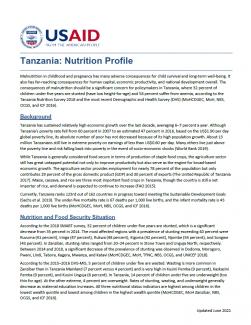Tanzania has sustained relatively high economic growth over the last decade, averaging 6–7 percent a year. Although Tanzania's poverty rate fell from 60 percent in 2007 to an estimated 47 percent in 2016, based on the US$1.90 per day global poverty line, its absolute number of poor has not decreased because of its high population growth. About 13 million Tanzanians still live in extreme poverty on earnings of less than US$0.60 per day. Many others live just above the poverty line and risk falling back into poverty in the event of socio-economic shocks (World Bank 2019).
While Tanzania is generally considered food secure in terms of production of staple food crops, the agriculture sector still has great untapped potential not only to improve productivity but also serve as the engine for broad-based economic growth. The agriculture sector provides employment for nearly 78 percent of the population but only contributes 29 percent of the gross domestic product (GDP) and 30 percent of exports (The United Republic of Tanzania 2017). Maize, cassava, and rice are three most important food crops in Tanzania, though the country is still a net importer of rice, and demand is expected to continue to increase (FAO 2015).
Currently, Tanzania ranks 123rd out of 162 countries in progress toward meeting the Sustainable Development Goals (Sachs et al. 2019). The under-five mortality rate is 67 deaths per 1,000 live births, and the infant mortality rate is 43 deaths per 1,000 live births (MoHCDGEC, MoH, NBS, OCGS, and ICF 2016).

